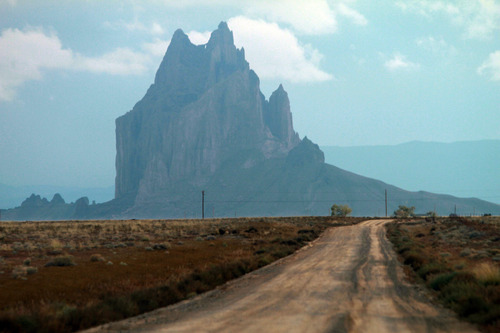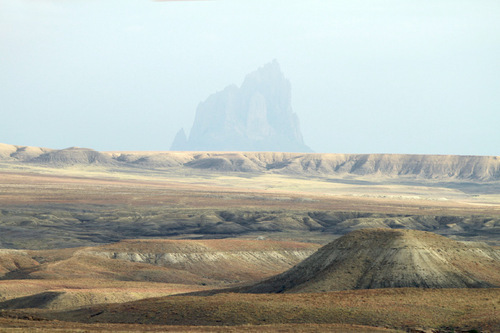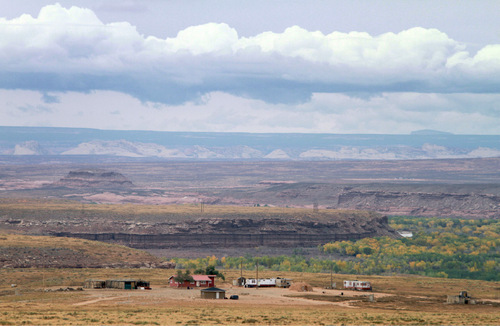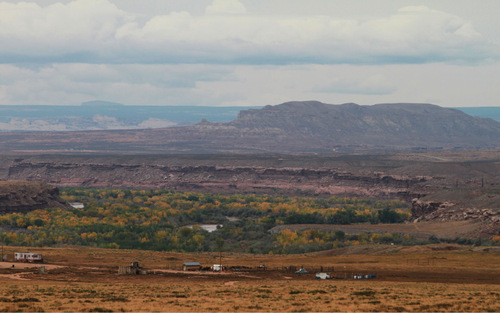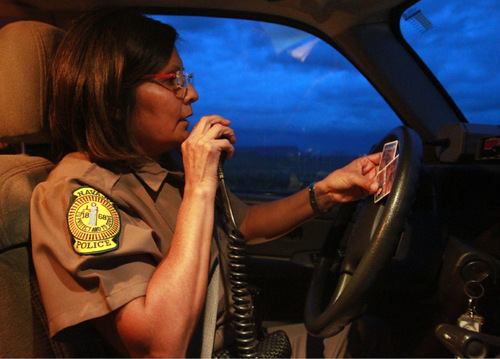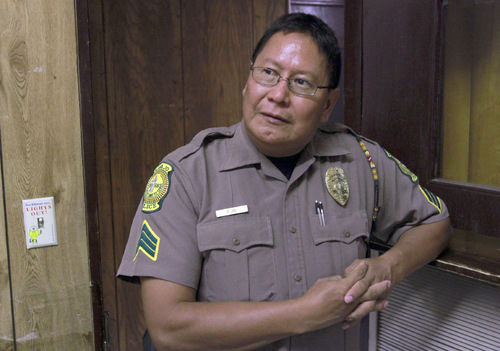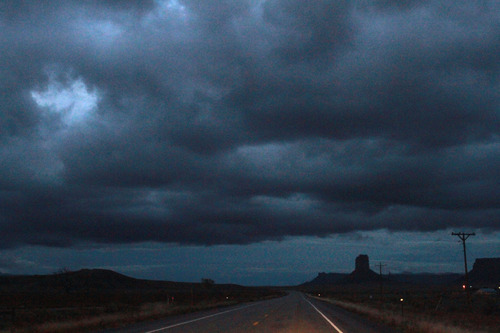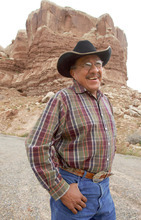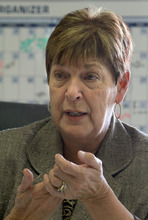This is an archived article that was published on sltrib.com in 2010, and information in the article may be outdated. It is provided only for personal research purposes and may not be reprinted.
Montezuma Creek • Police Officer Heather Tolth gestured toward a small collection of neat, modular homes as she drove her SUV on a road cutting through miles of sage-covered plain on Utah's section of the 27,000-square-mile Navajo Nation.
"That's a good family," she said with a smile. "We don't know the good families."
Here, the earth is not divided into a network of streets, stoplights and subdivisions. Beyond the highway, dirt roads can be treacherous, and people live in small collections of homes with their extended families. There are often only three Navajo officers on duty in Tolth's district, and it can take them two to three hours to respond to 911 calls.
Tolth knows her territory. But in a larger sense, a lack of consistent data has meant crime on the country's American Indian reservations is not well understood.
Although the FBI's Uniform Crime Report every year collects, analyzes and publishes crime statistics from the rest of the country, no more than a handful of tribal police agencies has ever been included during the report's 80-year history.
"You're in the dark, trying to make policy in the dark," said Duane Champagne, a University of California Los Angeles sociology professor who studies Indian justice. "Without any crime data, it's very difficult to gauge just what's happening in Indian Country and just how to address issues."
A new program is changing that. For the first time, the 2009 Crime Report gathered data from 86 tribal police departments, including Utah's Uintah and Ouray reservation and the Navajo Nation, which is partially in Utah. Numbers released in September are expected to guide tribes and policymakers in Washington, D.C., and ensure tribes are eligible for federal grants that could give them more resources to stem crime.
"It's healthy that some attention is being paid to this problem," said Larry EchoHawk, assistant secretary for Indian Affairs at the Department of the Interior.
—
'Forgotten people' • What data does exist about American Indian crime points to a serious problem.
A 2004 analysis of National Crime Victimization Survey data, based on phone interviews, found American Indians suffer violent crime at twice the rate of other Americans. But it also revealed the limitations of available data, Bureau of Justice Statistics statistician Steven W. Perry said.
There was no national tally of arrests on reservations. Tribal police did not consistently report arrest numbers and neither did the FBI, which investigates serious crime on reservations.
"You serve folks who, in many ways, are the forgotten people of this country," said John D. Wright, a supervising senior reservation agent for the FBI.
As new Indian Country crime numbers are reported and analyzed, they may challenge some assumptions.
A lack of current population counts thwarts exact conclusions about the data released this fall. New reservation census counts will be available early next year. But an initial Salt Lake Tribune analysis indicates that per-capita rates of robberies, burglaries and aggravated assaults on Navajo land seem to be in line with similar rates elsewhere in Utah and nationwide.
Of the 21 violent crimes reported on the Northern Ute tribe's Uintah and Ouray reservation last year, 20 were aggravated assaults, and the other crime was a rape. Per capita, those numbers don't appear to be higher than the national per-capita rates.
The findings may surprise some, acknowledged Samson Cowboy, Navajo director of public safety.
"The crime is not as high as what people say," he said. "If there's a major crime that happens, I think everyone gets on their high horse and says we have this [big crime problem]."
But the Tribune analysis does point to a serious rape problem. Navajo police reported 374 rapes last year, a number that per capita seems significantly higher than the rest of the nation.
—
'There's got to be a way' • Tolth helped investigate one of those rapes, which happened at a remote oil well about four miles north of Montezuma Creek.
It started when the victim ran into 42-year-old Johnson Joe. She knew him from working on construction sites together, according to federal court documents. The Tribune typically does not name victims of sexual assault.
He invited her to have some drinks with his girlfriend, 40-year-old Cynthia Bitsuie Jones, and two of her children, Tolth said. They gathered at an oil well, staying in their cars to drink the beer because the night was cold.
Shortly after midnight, Jones appeared to take offense to something the victim said and started hitting her. She fell to the ground.
Continuing the beating, she ripped off the victim's clothes and held her down. Jones urged her son and boyfriend to assault her.
Jones' son, 21-year-old Michael Whitehorse, could not complete the attack, but turned and smashed out the rear windows of her car. Joe assaulted her.
She yelled for help but passed out. The other three got into Jones' car and drove away.
After she awoke, the victim pulled herself up and found her clothes. Her Carhartt jacket, car keys and cell phone were missing. If she tried to walk, she could be lost in the desert, and even if she reached Montezuma Creek, the small town doesn't have a hospital. She had to drive.
She found her pocket-knife-like Leatherman tool, and used it to start her car. Her injured eyes had swollen so large she could hardly see. Confused and frightened, she took several wrong turns before she was able to make it to a hospital.
Doctors treated her for 42 bruises, cuts and lacerations. Along with her injuries, she struggled to cope with the fact that her assailants had left her alone, knowing she could die during the winter night and not seeming to care, Assistant U.S. Attorney Trina Higgins said.
It's the kind of case that Kristine Paul, the executive director at Gentle Ironhawk Shelter in Blanding, sees far too often. Up to 85 percent of the victims who come to the domestic-violence shelter, many of whom are native women, have been raped or sexually abused at some point in their lives. Many have never reported it.
"A lot of what we're doing is damage control. There are just so many victims," she said. Her group is working to create prevention programs, but the Navajo cultural and language barriers make it a challenge.
As crime numbers come in and the picture becomes clearer, new research and grants could give her more clues.
"It's got to stop. There's got to be a way," Paul said.
—
Data equal grants • Resources available to fight all types of crime on the Navajo reservation are scarce.
At the Shiprock, N.M., police station, for example, a holding cell is supposed to fit 40 people, but "we exceed that maximum all the time," said Navajo police Sgt. Phillip Joe. "We'll arrest someone in the morning and release them four to six hours later."
If part of the way to stop crime is to get more resources to fight it, data collection can help.
Prior to this year, many tribes had been collecting and reporting crime data, but they had been submitting it to the Bureau of Indian Affairs, not the Bureau of Justice Statistics. Because those numbers weren't reported to the right agency, tribes were losing out on tens of thousands of dollars in federal aid from the Justice Assistance Grants program, which doles out cash to police departments that show they need it based on Uniform Crime Report numbers.
Simply sending crime data to the right agency meant $750,000 for about 20 tribes this year, including more than $90,000 for the Navajos, said Perry, the statistician. He's heading up a new program to train tribal police on how to submit their crime numbers.
The effort, begun with stimulus funds, will continue under a new law passed in July. After the Obama administration took over, Attorney General Eric Holder held a series of listening sessions with tribes around the country. The Tribal Law and Order Act is designed to expand the powers of tribal courts, allow tribes to access off-reservation crime records and strengthen the protocols for investigating sexual assault.
It directs the secretary of the Interior to provide grants to collect and analyze crime data from the country's 565 federally recognized tribes.
It's not clear how long that will take. About 140 have reported so far, though not all were included in the 2009 Uniform Crime Report. That's a large portion — 70 percent — of the approximately 200 reservations that have their own police force.
But many smaller reservations rely on local non-Indian police to patrol their communities, or Bureau of Indian Affairs officers. And the FBI investigates all felony crimes on all reservations.
Getting consistent crime data from different agencies could take a long time, Perry said.
"There needs to be more accountability," he said. "And that includes the tribes."
Meanwhile, on the Navajo reservation, the population is growing as people move back home following the recession, Tolth said. And that means Navajo leaders absolutely must add to their approximately 380-officer force, retired Navajo criminal investigator Henry Lee said.
"There is getting to be more violence out here compared to 25 years ago," he said. "It's getting worse. It's going to get worse."
And that means more victims trying to heal.
—
The aftermath • After her December rape near Montezuma Creek, the sturdily built woman with long curly hair and high cheekbones locked her door. She shut out her five sons when they tried to get her to eat something, too ashamed to tell them what had happened.
"My 8-year-old was embarrassed because of my face being bruised," she wrote in a statement to U.S District Court.
She couldn't talk with the children on the school bus she drove. She was afraid her attackers or their relatives would come back. After the sun set, nightmares kept her awake.
She had to force herself to do the things she loves: work on cars, sew and spend time outdoors enjoying the reservation's mesas and rock formations.
But she was able to report the crime and aid the investigation by Navajo police and the FBI. The U.S. Attorney's Office filed federal charges against her attackers.
This summer, all three pleaded guilty: Jones and Joe to aggravated sexual abuse and Whitehorse to abusive sexual contact.
She was present when Whitehorse, the first of the three, was sentenced to 46 months in federal prison last month. She sat with her arms folded during the hearing, as if trying to make herself smaller on the courtroom bench. But her face was set. When she stood to address the judge, she paused for several moments, then simply thanked the prosecutors.
"It's hard for me to come up here and get this over with," she said.
Ramping up reservation justice
After Attorney General Eric Holder convened a series of listening sessions with tribal leaders around the country last year, he announced the addition of 33 new assistant U.S. attorneys to prosecute crime on American Indian reservations nationwide, including one in Utah. —
Support for this story
The reporting of this story was supported in part by the Center on Media, Crime and Justice at John Jay College in New York and the McCormick Foundation. —
Online FBI crime statistics
O See 2009 FBI Uniform Crime Statistics for 86 tribal areas across the U.S., including the Navajo Nation
> extras.sltrib.com/ tribal_crime


